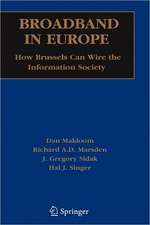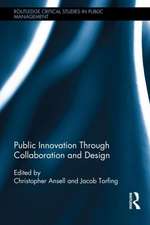Agile It Organization Design: For Digital Transformation and Continuous Delivery
Autor Sriram Narayanen Limba Engleză Paperback – 13 iun 2015
- Govern for value over predictability
- Organize for responsiveness, not lowest cost
- Clarify accountability for outcomes and for decisions along the way
- Strengthen the alignment of autonomous teams
- Move beyond project teams to capability teams
- Break down tool-induced silos
- Choose financial practices that are free of harmful side effects
- Create and retain great teams despite today s talent crunch
- Reform metrics to promote (not prevent) agility
- Evolve culture through improvements to structure, practices, and leadership and careful, deliberate interventions
Preț: 241.43 lei
Nou
46.20€ • 48.23$ • 38.23£
Carte disponibilă
Livrare economică 10-17 martie
Livrare express 28 februarie-06 martie pentru 29.73 lei
Specificații
ISBN-10: 0133903354
Pagini: 304
Ilustrații: illustrations
Dimensiuni: 178 x 231 x 15 mm
Greutate: 0.49 kg
Editura: Addison-Wesley Professional
Notă biografică
Sriram Narayan, an IT management consultant with ThoughtWorks, has provided IT agility guidance to clients in telecom, financial services, energy, retail, and Internet businesses. He has also served as a leadership coach and a director of innovation. He was a founding member of the ThoughtWorks technology advisory board-the group that now authors Technology Radar. During a two-year stint at the products division of ThoughtWorks, he helped with product innovation and advocacy on Go-a tool that helps with continuous delivery. He has also worn the hats of a developer, open-source contributor, manager, product owner, tester, SOA architect, trainer, and Agile coach. An occasional blogger and speaker at conferences, his writings, talks, and contact information are available from sriramnarayan.com. The opinions in this book are his own.
Cuprins
Preface xix
Acknowledgments xxiii
About the Author xxv
Glossary xxvii
Chapter 1: Context 1
1.1 Focus 2
1.2 Business, IT, and Shadow IT 3
1.3 Business-IT Effectiveness 5
1.4 Digital Transformation 7
1.5 Bimodal IT and Dual Operating Systems 10
1.6 Angles of Coverage 10
1.7 Summary 11
Chapter 2: The Agile Credo 13
2.1 Understanding the Agile Manifesto 14
2.2 Continuous Delivery and DevOps 15
2.3 Agile Culture 16
2.4 Common Themes 18
2.5 Isn't Agile Dead? 21
2.6 Summary 22
Chapter 3: Key Themes 25
3.1 Software Development Reconsidered 26
3.2 Govern for Value over Predictability 28
3.3 Organize for Responsiveness over Cost-efficiency 30
3.4 Design for Intrinsic Motivation and Unscripted Collaboration 33
3.5 Summary 35
Chapter 4: Superstructure 37
4.1 Business Activities and Outcomes 37
4.2 Centralization and Decentralization 41
4.3 Silos 42
4.4 Summary of Insights 45
4.5 Summary of Actions 46
Chapter 5: Team Design 47
5.1 Framing the Problem 47
5.2 Activity-oriented Teams 48
5.3 Shared Services 54
5.4 Cross-functional Teams 56
5.5 Cross-functionality in Other Domains 61
5.6 Migrating to Cross-functional Teams 63
5.7 Communities of Practice 65
5.8 Maintenance Teams 65
5.9 Outsourcing 66
5.10 The Matrix: Solve It or Dissolve It 68
5.11 Summary of Insights 72
5.12 Summary of Actions 73
Chapter 6: Accountability 75
6.1 Power and Hierarchy 75
6.2 Balance Autonomy with Accountability 77
6.3 Assign Accountability 78
6.4 Minimize Power Struggles 82
6.5 Decide on an Outcome Owner 85
6.6 Migration 86
6.7 Decision Accountability 86
6.8 Planning and Execution 92
6.9 Org Chart Debt 97
6.10 Summary of Insights 98
6.11 Summary of Actions 98
Chapter 7: Alignment 99
7.1 Articulate Strategy for General Alignment 99
7.2 Aligning IT with Business 101
7.3 Structural Alignment 105
7.4 Making Business Play Its Part 107
7.5 Summary of Insights 108
7.6 Summary of Actions 108
Chapter 8: Projects 109
8.1 What Is Wrong with Plan-driven Software Projects? 109
8.2 Budget for Capacity, Not for Projects 110
8.3 Business-capability-centric IT 112
8.4 Project Business Cases 115
8.5 Value-driven Projects 117
8.6 Project Managers 119
8.7 Governance 120
8.8 Change Programs and Initiatives 121
8.9 Summary of Insights 123
8.10 Summary of Actions 123
Chapter 9: Finance 125
9.1 Relevance 125
9.2 Cost Center or Profit Center 126
9.3 Chargebacks 126
9.4 CapEx and OpEx 127
9.5 Conventional Budgeting 130
9.6 Agile Budgeting 132
9.7 Summary of Insights 134
9.8 Summary of Actions 135
Chapter 10: Staffing 137
10.1 Dealing with the Talent Crunch 137
10.2 Go Beyond Project Teams 139
10.3 Better Staffing 141
10.4 Summary of Insights 146
10.5 Summary of Actions 147
Chapter 11: Tooling 149
11.1 Access Control for Unscripted Collaboration 149
11.2 Subtle Effects of the Toolchain 151
11.3 Technology Isn't Value Neutral 154
11.4 Tool Evaluation 157
11.5 Summary of Insights 158
11.6 Summary of Actions 158
Chapter 12: Metrics 159
12.1 Metrics Don't Tell the Whole Story 159
12.2 Dashboards Promote Ignorance 162
12.3 The Problem with Targets and Incentives 163
12.4 Reforming the Metrics Regime 171
12.5 Designing Better Metrics 175
12.6 Objections to Metrics Reform 178
12.7 Migration 179
12.8 Summary of Insights 180
12.9 Summary of Actions 181
Chapter 13: Norms 183
13.1 What Are Norms? 183
13.2 Reinforcing Norms 184
13.3 Cooperation over Competition 186
13.4 Living Policies 187
13.5 Consistency over Uniformity 189
13.6 Ask for Forgiveness, Not for Permission 192
13.7 Confidential Surveys 193
13.8 Balance Theory and Practice 193
13.9 Summary of Insights 195
13.10 Summary of Actions 195
Chapter 14: Communications 197
14.1 Intrinsic Motivation 197
14.2 Interpersonal Communications: Problems 198
14.3 Interpersonal Communications: Mitigation 203
14.4 Scaling Employee Engagement through Internal Communications 204
14.5 Deliberating in Writing 208
14.6 The Use and Misuse of Visual Aids 211
14.7 Documents, Reports, and Templates 216
14.8 Summary of Insights 217
14.9 Summary of Actions 217
Chapter 15: The Office 219
15.1 Open-plan Layouts 219
15.2 Ergonomics 222
15.3 Remote Working 224
15.4 Summary of Insights 225
15.5 Summary of Actions 225
Chapter 16: Wrap-up 227
16.1 Summary of Effects 227
16.2 Order of Adoption 233
16.3 Information Radiators 234
16.4 Sample Exercise 235
16.5 IT Services 236
16.6 GICs 240
16.7 Beyond IT 243
Bibliography 245
Index 247






















